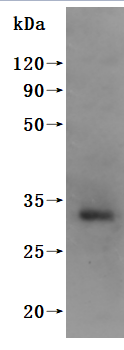CT83, also known as CXorf61 or KK-LC-1, is a small protein of 113 amino acids with unknown function, primarily expressed in mature sperm [1]. However, CT83 is also identified as a tumor antigen expressed in various cancer tissues and testicular germ cells [2]. It is a member of the cancer-testis antigenic protein family and is exclusively expressed in malignant tumor tissue and testicular germ cells [3]. The Human Protein Atlas data revealed that CT83 transcripts were expressed in lung, stomach, colorectal, urothelial, cervix, and breast cancers, as well as in various tumor cell lines [4]. Additionally, CT83, also known as Kita-Kyushu lung cancer antigen-1 (KK-LC-1), has been recognized as a cancer-testis antigen overexpressed in liver cancer [5]. Furthermore, CT83 has been identified as a CTA recognized by cytotoxic T lymphocytes [6]. It is important to note that CT83 does not appear to be expressed by vital human tissues, as it was not detected in a panel of non-neural (except germ cells) and neural tissues [7]. Moreover, CT83 has been suggested as a potential target in lung cancer and has been found to be expressed in 65% of triple-negative breast cancer cases [8].
References:
[1] M. Laisné, S. Benlamara, N. André, L. Djerroudi, N. Gupta, D. Daheret al., "Cancer/testis genes are predictive of breast tumor subtypes",, 2021. https://doi.org/10.1101/2021.10.27.465656
[2] C. Haider, J. Hnat, R. Wagner, H. Huber, G. Timelthaler, M. Grubingeret al., "Transforming growth factor‐β and axl induce cxcl5 and neutrophil recruitment in hepatocellular carcinoma", Hepatology, vol. 69, no. 1, p. 222-236, 2018. https://doi.org/10.1002/hep.30166
[3] J. Chen, A. Wang, G. Lyu, K. Zhou, J. Ke, X. Jiet al., "An innovative prognostic model based on four genes in asian patient with gastric cancer", SSRN Electronic Journal, 2019. https://doi.org/10.2139/ssrn.3391354
[4] Z. Ye, Y. Liang, Y. Ma, B. Lin, L. Cao, B. Wanget al., "Targeted photodynamic therapy of cancer using a novel gallium (iii) tris (ethoxycarbonyl) corrole conjugated‐mab directed against cancer/testis antigens 83", Cancer Medicine, vol. 7, no. 7, p. 3057-3065, 2018. https://doi.org/10.1002/cam4.1601
[5] Z. Chen, X. Zuo, L. Pu, Y. Zhang, G. Han, L. Zhanget al., "Hypomethylation‐mediated activation of cancer/testis antigen kk‐lc‐1 facilitates hepatocellular carcinoma progression through activating the notch1/hes1 signalling", Cell Proliferation, vol. 52, no. 3, 2019. https://doi.org/10.1111/cpr.12581
[6] J. Ji, J. Chen, A. Wang, W. Zhang, H. Ju, Y. Liuet al., "Kk-lc-1 may be an effective prognostic biomarker for gastric cancer",, 2020. https://doi.org/10.21203/rs.3.rs-50773/v2
[7] B. Marcinkowski, S. Stevanović, S. Helman, S. Norberg, C. Serna, B. Jinet al., "Cancer targeting by tcr gene-engineered t cells directed against kita-kyushu lung cancer antigen-1", Journal for Immunotherapy of Cancer, vol. 7, no. 1, 2019. https://doi.org/10.1186/s40425-019-0678-x
[8] R. Lam, T. Tien, C. Joseph, J. Lim, A. Thike, J. Iqbalet al., "Cancer-testis antigens in triple-negative breast cancer: role and potential utility in clinical practice", Cancers, vol. 13, no. 15, p. 3875, 2021. https://doi.org/10.3390/cancers13153875






